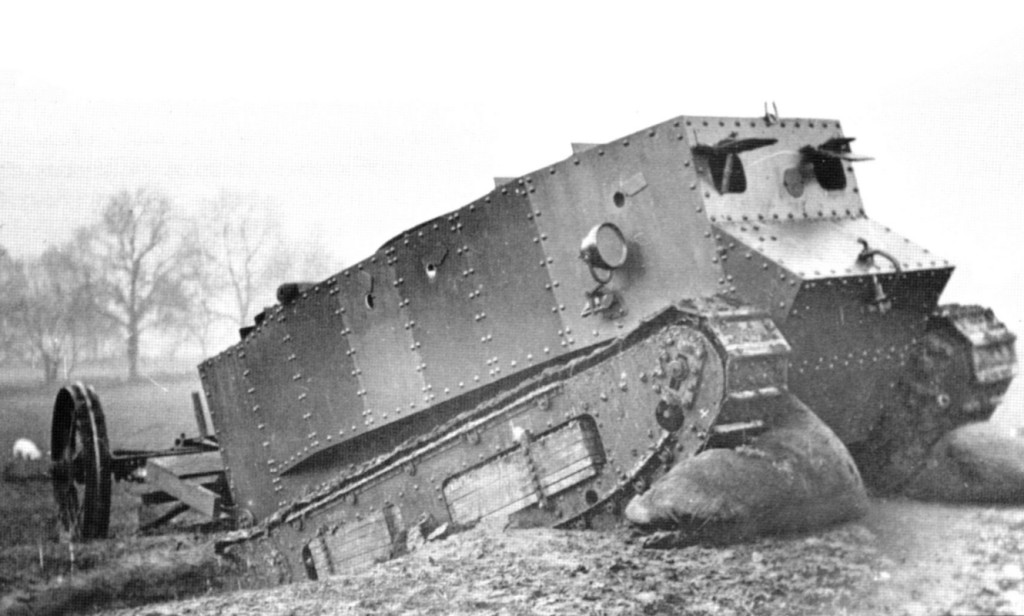

We somehow let September slip past without a War on the Rocks toast to a military innovation that changed history — the tank, or what was initially called a “landship.”
One hundred years ago last month the first battle tank rolled off an assembly line in England. Weighing some 14 tons, carrying three crew, and able to reach a top speed of 3 miles per hour, the “Little Willie” was the prototype modern tank that helped bring about a new period in the history of land warfare.
Little Willie was unable to cross the trench-line defenses it was designed to overcome, easily overheated, and was quickly replaced by a new version dubbed “Big Willie.” A year later, on September 15, the British Mark I made its combat debut at the First Battle of the Somme and in November 1917 the much improved and storied British Mark IV tank was used at Cambrai.
A toast to Little Willie, which survives today at The Tank Museum in Bovington, England, seems appropriate considering the role of the tank and armor in general, and the more complex role of interwar armored warfare developments in military innovations studies. Indeed, the story of how the United States, French, British, and Russians adopted and adapted to armored warfare, evolved doctrine, and integrated the tank into combined arms operations remains an important case study for students of military innovation. How respective military analysts and leaders interpreted the emergence of the tank and viewed its role on future battlefields provides lessons for today’s students of military technology, doctrinal innovation, and the diffusion of military innovations.
What, then, do we use to toast Little Willie?
One option is the Friggin’ Willie — a nod to the legacy of misreading the actual role of the tank in interwar military innovation, the myth of the Blitzkrieg in post-World War II military history, and the larger issue of defense analysts missing the importance of doctrine, force employment, and other considerations when assessing foreign military innovations.
To make a perfect Friggin’ Willie, mix equal portions of amaretto vodka and lime juice, shake with ice, and strain into your War on the Rocks tumbler. I recommend Pinnacle’s Amaretto Vodka, which won a silver award at the 2014 International Wine and Spirit Competition.
For those seeking a more historically appropriate beverage for World War I (a time when the British attempted to reduce alcohol consumption), consider a toast to Little Willie with the rum that was a favorite of British soldiers on the front lines. “Tommy” preferred strong rum, but for our toast I recommend Angostura Single Barrel Reserve. British soldiers on the front received a ration of a “quarter-gill” per day, or about an ounce. Perhaps Little Willie deserves a half-gill, over ice (or neat, if you want the true “Tommy” experience).
Army readers familiar with “grog bowls” served at dining-ins or other celebrations do not have to look very hard for a service-appropriate toast to Little Willie. Traditional grog mixes pay homage to a unit’s history, such as that of the only Army unit to fight in World War I as cavalry, horses and all — the 2nd Cav “Dragoons.” Their traditional grog mix includes a nice Bordeaux in honor of the Dragoons’ service at the Argonne and the Marne, reflected today in the unit crest by the motto Toujours Pret (always ready) and a fleur-de-lis. Less discriminating drinkers can toast with more pedestrian red wine, remembering the practice of French soldiers to partake in a daily ration of “Pinard,” a low-quality wine issued on the front at a rate of a half-liter per day.
To toast the origins of the tank we don’t need to be too creative. Alcohol was considered pivotal to maintain the morale of troops, and World War I spurred the early 20th-century boon in homefront cocktails. One example is the venerable sidecar, named for the motorcycle sidecar and consisting of a mix of chilled, shaken, strained cognac, triple sec (or Gran Marnier), and lemon juice. A final option is one of our favorite liqueurs, Benedictine, a drink popularized at the end of World War I as troops demobilized through Belgium, Paris, and on to England. Try Benedictine D.O.M., a concoction originating around 1700 at the hands of Benedictine monks using some 27 botanicals for flavor.
Regardless of how you toast Little Willie, as the 2015 Association of the United States Army conference comes to an end, we should all be thinking about the role of the tank in past military innovations and its role in land warfare moving forward.
Robert R. Tomes, PhD is President of the MapStory Foundation and an adjunct professor of security policy studies at Georgetown University. His publications include U.S. Defense Strategy from Vietnam to Operation Iraqi Freedom: Military Innovation and the New American Way of War, 1973-2003 (Routledge, 2007), which analyzes the Cold War offset strategy as a case study in military innovation. A former intelligence community senior manager, he served as a co-chair of an interagency working group on alternative analysis.
